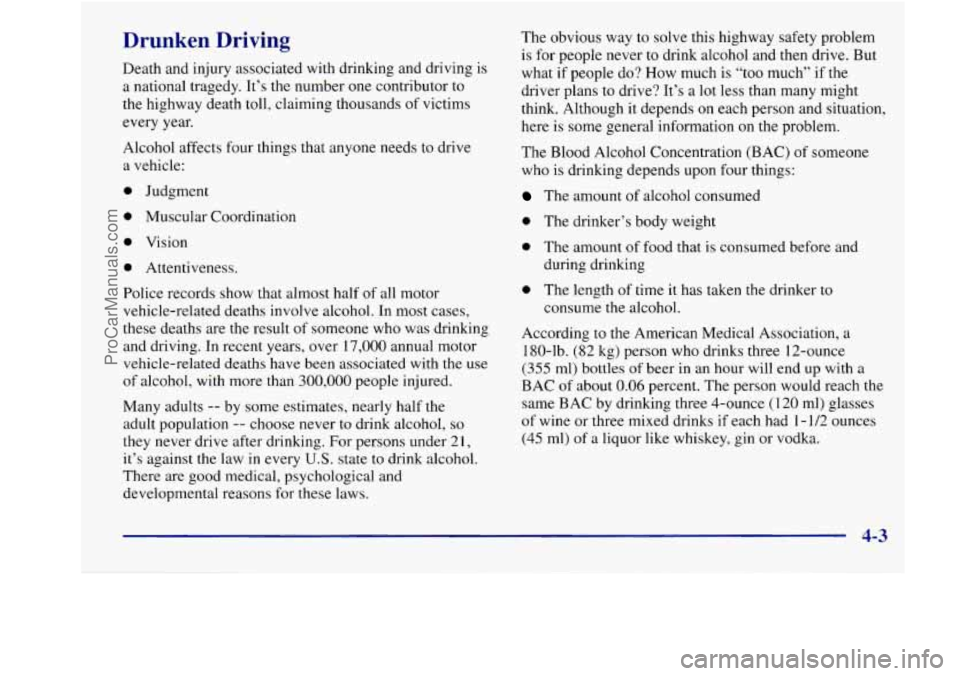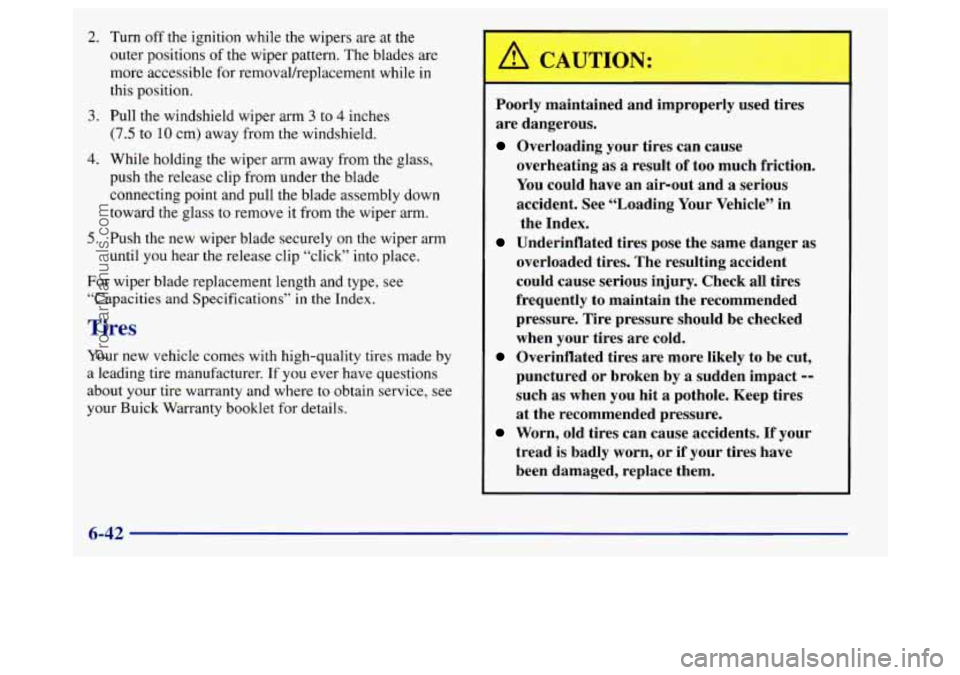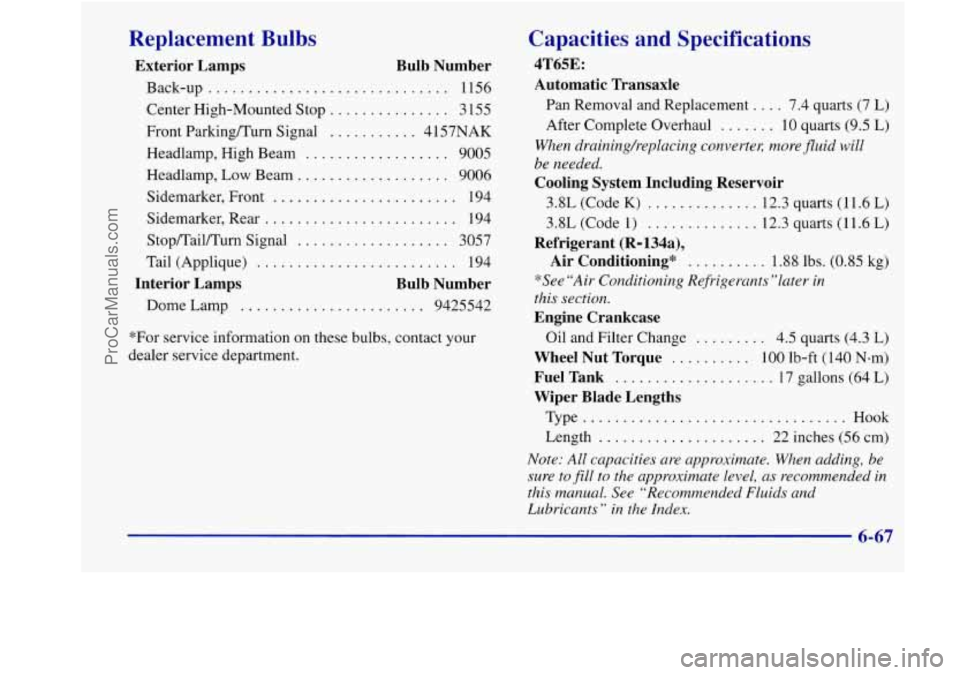length BUICK REGAL 1998 Owners Manual
[x] Cancel search | Manufacturer: BUICK, Model Year: 1998, Model line: REGAL, Model: BUICK REGAL 1998Pages: 388, PDF Size: 20.19 MB
Page 187 of 388

Drunken Driving
Death and injury associated with drinking and driving is
a national tragedy. It’s the number one contributor to
the highway death toll, claiming thousands of victims
every year.
Alcohol affects four things that anyone needs to drive
a vehicle:
0 Judgment
0 Muscular Coordination
0 Vision
0 Attentiveness.
Police records show that almost half of all motor
vehicle-related deaths involve alcohol. In most cases,
these deaths are the result of someone who was drinking
and driving. In recent years, over 17,000 annual motor
vehicle-related deaths have been associated with
the use
of alcohol, with more than
300,000 people injured.
Many adults
-- by some estimates, nearly half the
adult population
-- choose never to drink alcohol, so
they never drive after drinking. For persons under 21,
it’s against the law in every U.S. state to drink alcohol.
There are good medical, psychological and
developmental reasons for these laws. The
obvious way to solve this highway safety problem
is for people never
to drink alcohol and then drive. But
what if people do? How much is “too much” if the
driver plans to drive? It’s a lot less than many might
think. Although it depends on each person and situation,
here is some general information on the problem.
The Blood Alcohol Concentration
(BAC) of someone
who is drinking depends upon four things:
The amount of alcohol consumed
0 The drinker’s body weight
0 The amount of food that is consumed before and
during drinking
0 The length of time it has taken the drinker to
consume the alcohol.
According to the American Medical Association, a
180-lb. (82 kg) person who drinks three 12-ounce
(355 ml) bottles of beer in an hour will end up with a
BAC of about
0.06 percent. The person would reach the
same BAC by drinking three 4-ounce
(1 20 ml) glasses
of wine or three mixed drinks if each had
1 - 1/2 ounces
(45 ml) of a liquor like whiskey, gin or vodka.
4-3
ProCarManuals.com
Page 306 of 388

2. Turn off the ignition while the wipers are at the
outer positions of the wiper pattern. The blades are
more accessible for removalh-eplacement while in
this position.
3. Pull the windshield wiper arm 3 to 4 inches
(7.5 to 10 cm) away from the windshield.
4. While holding the wiper arm away from the glass,
push the release clip from under the blade
connecting point and pull the blade assembly down
toward the glass to remove it from the wiper arm.
5. Push the new wiper blade securely on the wiper arm
until
you hear the release clip “click” into place.
For wiper blade replacement length and type, see
“Capacities and Specifications”
in the Index.
Tires
Your new vehicle comes with high-quality tires made by
a leading tire manufacturer. If you ever have questions
about your tire warranty and where
to obtain service, see
your Buick Warranty booklet for details.
Poorly maintained and improperly used tires
are dangerous.
Overloading your tires can cause
overheating
as a result of too much friction.
You could have an air-out and
a serious
accident. See “Loading Your Vehicle” in
the Index.
Underinflated tires pose the same danger as
overloaded tires. The resulting accident
could cause serious injury. Check all tires
frequently to maintain the recommended
pressure. Tire pressure should be checked
when your tires are cold.
Overinflated tires are more likely to be cut,
punctured or broken by a sudden impact
--
such as when you hit a pothole. Keep tires
at the recommended pressure.
Worn, old tires can cause accidents. If your
tread
is badly worn, or if your tires have
been damaged, replace them.
6-42
ProCarManuals.com
Page 331 of 388

Replacement Bulbs
Exterior Lamps Bulb Number
Back-up .............................. 1156
Center High-Mounted Stop
............... 3155
Front Parking/Turn Signal
........... 4 157NAK
Headlamp, High Beam
.................. 9005
Headlamp, Low Beam.
.................. 9006
Sidemarker, Front ....................... 194
Sidemarker, Rear
........................ 194
Stop/Tail/Turn Signal
................... 3057
Tail (Applique)
....................... 194
Interior Lamps Bulb Number
Dome Lamp ....................... 9425542
*For service information on these bulbs, contact your
dealer service department.
Capacities and Specifications
4T65E:
Automatic Transaxle
Pan Removal and Replacement .... 7.4 quarts (7 L)
After Complete Overhaul
....... 10 quarts (9.5 L)
When drainingheplacing converter; more fluid will
be needed.
Cooling System Including Reservoir
3.8L (Code K) .............. 12.3 quarts (11.6 L)
3.8L (Code 1)
.............. 12.3 quarts (11.6 L)
Air Conditioning* .......... 1.88 lbs. (0.85 kg)
Refrigerant (R-l34a),
*See “Air Conditioning Refrigerants ”later in
this section.
Engine Crankcase
Oil and Filter Change ......... 4.5 quarts (4.3 L)
Wheel Nut Torque .......... 100 lb-ft (140 N-m)
Fuel Tank .................... 17 gallons (64 L)
Wiper Blade Lengths
Type ................................. Hook
Length ..................... 22 inches (56 cm)
Note: All capacities are approximate. When adding, be
sure
to fill to the approximate level, as recommended in
this manual. See “Recommended Fluids and
Lubricants” in the Index.
ProCarManuals.com
Page 332 of 388

Engine Specifications
3.8L (Code 1) 3.8L (Code K)
Type ............................. V6 ...................... V6
Displacement .................... 23 1 CID .................. 23 1 CID
Thermostat Temperature
......... 195°F (91°C) ............. 195°F (91°C)
Firing
Order
................... 1-6-5-4-3-2 .............. 1-6-5-4-3-2
Horsepower
................... .240 0 5200 ............... 195 0 5200
Vehicle Dimensions
Wheelbase .............. 109.0 inches (276.9 cm)
Tread (Front)
............. 62.1 inches (157.7 cm)
Tread (Rear)
.............. 6 1.2 inches ( 155.4 cm)
Overall Length
........... 196.2 inches (498.4 cm)
Overall Width ............. 72.7 inches (1 84.5 cm)
Overall Height
............ 56.6 inches (143.8 cm)
6-68
ProCarManuals.com